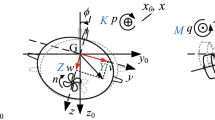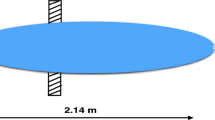Abstract
This paper proposes a data-driven control approach on the basis of polynomial regressors for autonomous underwater vehicles (AUVs). In contrast to conventional control approach, data-driven control does not require modeling for the systems. It only utilizes the analysis of massive stored dataset to predict the future control input, which can achieve the future output. Generally, the massive stored dataset can be analyzed by short-length vectors linearly. In this paper, a novel point is the improvement of existing data-driven control by polynomial regressors, which improve the control performance of AUVs. By numerical simulations, we illustrate the effectiveness of our proposed approach.








Similar content being viewed by others
References
Li D (2016) Applications of wavelet algorithm in ship motion control system. Ship Science And Technology 38:49–51
Konaka E (2011) Design of discrete predictive controller using approximate nearest neighbor method. Proceedings of the 18th IFAC World Congress, pp 10213–10218
Konaka E (2012) Machine-learning-based controller design for discretevalued input systems. IEEJ Transactions on Electronics Information and Systems 132:897–906
Nakpong N, Yamamoto S (2012) Just-in-time predictive control for a two-wheeled robot. Proceedings of 2012 tenth international conference on ICT and knowledge engineering 3:95–98
Zhang H, Zheng WX (2018) Denial-of-service power dispatch against linear quadratic control via a fading channel. IEEE Trans Autom Control 63(9):3032–3039
Zhang D, Shen R, Ren J, Zhang Y (2018) Delay-optimal proactive service framework for block-stream as a service. IEEE Wireless Commun Lett 7(4):598–601
Zhang Y, He S, Chen J (2016) Data gathering optimization by dynamic sensing and routing in rechargeable sensor networks. IEEE/ACM Trans Netw 24(3):1632–1646
Peng X, Zhang J, Li P (2018) Fuzzy logic guidance of a control-configured autonomous underwater vehicle. In: Proceedings of the 37th Chinese Control Conference
Hassanein O, Anavatti S, Ray T, Modeling Fuzzy (2011) Fuzzy modeling and control for autonomous underwater vehicle. In: Proceedings of the 5th international conference on automation, robotics and applications, pp 169–174
Ban H, Yang X, Luo X, Yan J, Guan X (2017) Fuzzy-based tracking controller design for autonomous underwater vehicle. In: Proceedings of the 36th Chinese control conference, pp 4813–4818
Wang H, Chen Z, Bian X, Jia H, Xu G (2018) Robust adaptive path following control for autonomous underwater vehicles with virtual guidance. In: Proceeding of the 31st Chinese control conference, pp 4283–4288
Li Y, Guo H, Gong H, Jiang Y, An L, Ma T (2016) The improved adaptive hybrid fuzzy control of AUV horizontal motion. In: 13th international computer conference on wavelet active media technology and information processing, pp 408–414
Hu Y, Yu J, Yu H, Zhao L, Fu C (2018) Adaptive fuzzy command filtered control with error compensation mechanism for AUVs via backstepping. In: Proceedings of Chinese control and decision conference (CCDC), pp 1226–1230
Cui R, Yang C, Li Y, Sharma S (2017) Adaptive neural network control of AUVs with control input nonlinearities using reinforcement learning. IEEE Transactions on Systems, Man, and Cybernetics: Systems 47:1019–1029
Miao B, Li T, Luo W (2013) A DSC and MLP based robust adaptive NN tracking control for underwater vehicle. Neurocomputing: 184–189
Zhang Y, Gao L, Liu W, Li L (2017) Research on control method of AUV terminal sliding mode variable structure. In: 2017 international conference on robotics and automation sciences, pp 88–93
Konar S, Patil MD, Vyawahare VA (2018) Design of a fractional order sliding mode controller for depth control of AUV. In: 2018 Second international conference on intelligent computing and control systems, pp 1342–1345
Shi X, Yang C, Xie W, Liang C, Shi Z, Chen J (2018) Anti-drone system with multiple surveillance technologies: architecture, implementation, and challenges. IEEE Communications Magazine 56:68–74
Tong F, Sun Y, He S (2019) On positioning performance for the narrow-band internet of things: how participating eNBs impact? IEEE Transactions on Industrial Informatics 15:423–433
Shi X, Wu J (2019) To hide private position information in localization using time difference of arrival. IEEE Trans Signal Process 66:4946–4956
Deng R, He S, Cheng P, Sun Y (2017) Towards balanced energy charging and transmission collision in wireless rechargeable sensor networks. J Commun Netw 19:341–350
Zhang H, Meng W, Qi J, Wang X, Zheng WX (2019) Distributed load sharing under false data injection attack in inverter-based microgrid. IEEE Trans Ind Electron 66(2):1543–1551
Zhang Z, Zhang H, He S, Cheng P Bilateral privacy-preserving utility maximization protocol in database-driven cognitive radio networks. IEEE transactions on dependable and secure computing. (preprint)
Yang C, Shi Z, Zhang H, Wu J, Shi X Multiple attacks detection in cyber-physical systems using random finite set theory. IEEE Transactions on Cybernetics, Early Access
Zhang D, Tan L, Ren J, Awad MK, Zhang S, Zhang Y Near-optimal and truthful online auction for computation offloading in green edge-computing systems. IEEE Transactions on Mobile Computing, Early Access, https://doi.org/10.1109/TMC.2019.2901474
Yamamoto S (2014) A new model-free predictive control method using input and output data. Third International Conference on Key Engineering Materials and Computer Science 1042:182–187
Yamamoto S (2015) A model-free predictive control method by minimization. Proceedings of 10th Asian control conference, 1570064495
Yang A, Zhou Z, Ganesh A, Sastry S, Ma Y (2013) Fast-minimization algorithms for robust face recognition. IEEE Trans Image Process 8:3234–3246
Li H, Yamamoto S (2017) Model-free predictive control using polynomial regressors. SICE Journal of Control Measurement and System Integration 10:93–99
Fossen T (2011) Handbook of marine craft hydrodynamics and motion control[M]. Wiley, Hoboken
Fierro R, Lewis F (1997) Control of nonholonomic mobile robot: Backstepping kinematics into dynamics. J Robotic Sys 14:149–164
Inoue D, Yamamoto S (2004) An operation support system based on database-driven on demand predictive control. In: Proceedings of 2004 SICE annual conference, pp 2024–2027
Inoue D, Yamamoto S (2005) A memory-based predictive control approach to a braking assist problem, pp 3186–3189
Duan S, Zhang D, Wang Y, Li L, Zhang Y (2019) JointRec: a deep learning-based joint cloud video recommendation framework for mobile IoTs. IEEE Internet of Things, https://doi.org/10.1109/JIOT.2019.2944889
Zhang Y, Chen J, Cai L, Pan J (2019) Expanding EV charging networks considering transportation pattern and power supply limit. IEEE transactions on smart grid
Inoue D, Yamamoto S (2006) Support for drivers via just-in-time predictive control and fault detection based on a nearest neighbor method during braking to stop trains. Transactions of the Japan Society of Mechanical Engineers 72:2756–2761
Yang AY, Zhou Z, Ganesh A, Sastry SS, Ma Y (2013) Fast ℓ1-minimization algorithms for robust face recognition. IEEE Trans Image Process 22(8):3234–3246
Acknowledgments
This research was supported by the The National Ntural Science Foundation of China under Grant 61873106, National Nature Science Foundation of Jiangsu Province under Grant BK20171264, Jiangsu Qing Lan Project to Cultivate Middle-aged and Young Science Leaders, Jiangsu Six Talent Peak Project under Grants XYDXX-047, XYDXX-140, University Science Research General Research General Project of Jiangsu Province under Grant 18KJB520005, Lianyungang Hai Yan Plan under Grants 2018-ZD-003, 2018-QD-001, 2018-QD-012, and Natural Science Foundation Project of Huaihai Institute of Technology under Grant Z2017005.
Author information
Authors and Affiliations
Corresponding author
Additional information
Publisher’s note
Springer Nature remains neutral with regard to jurisdictional claims in published maps and institutional affiliations.
This article is part of the Topical Collection: Special Issue on Emerging Trends on Data Analytics at the Network Edge
Guest Editors: Deyu Zhang, Geyong Min, and Mianxiong Dong
Rights and permissions
About this article
Cite this article
Li, H., Xu, W., Zhang, H. et al. Polynomial regressors based data-driven control for autonomous underwater vehicles. Peer-to-Peer Netw. Appl. 13, 1767–1775 (2020). https://doi.org/10.1007/s12083-020-00878-6
Received:
Accepted:
Published:
Issue Date:
DOI: https://doi.org/10.1007/s12083-020-00878-6




